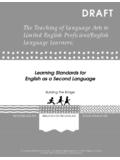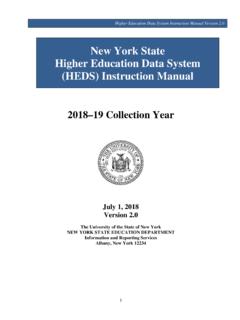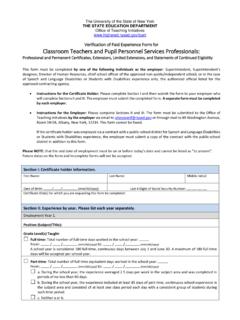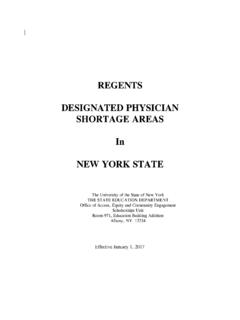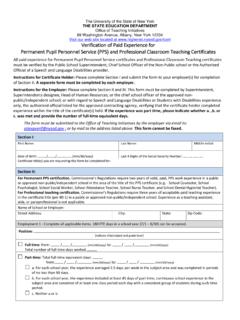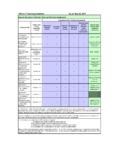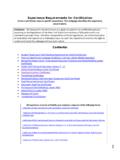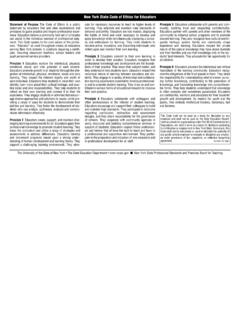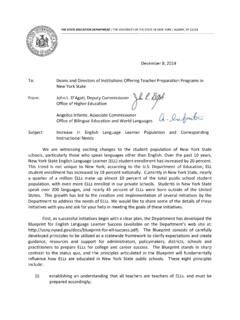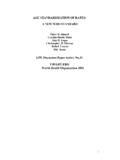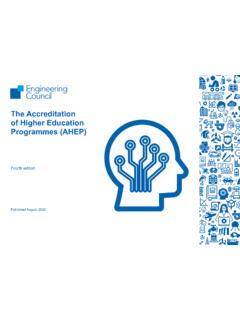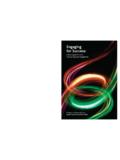Transcription of The New York State Teaching Standards - Office of Higher ...
1 The New York State Teaching Standards September 12, 2011 Page I. Knowledge of Students and Student Learning .. 1 II. Knowledge of Content and Instructional Planning .. 2 III. Instructional Practice .. 6 IV. Learning Environment .. 8 V. Assessment for Student 10 VI. Professional Responsibilities and Collaboration .. 12 VII. Professional Growth .. 14 1 Standard I: Knowledge of Students and Student Learning Teachers acquire knowledge of each student, and demonstrate knowledge of student development and learning to promote achievement for all students.
2 Element : Teachers demonstrate knowledge of child and adolescent development, including students cognitive, language, social, emotional, and physical developmental levels. Performance Indicators: a. Teachers describe orally or in writing an understanding of the developmental characteristics of their students. b. Teachers create developmentally appropriate lessons that address students learning differences and needs. c. Teachers implement lessons and modify instruction based upon students developmental needs.
3 Element : Teachers demonstrate knowledge of current research in learning and language acquisition theories and processes. Performance Indicators: a. Teachers design lesson plans and adjust instruction to include a variety of strategies that support the learning needs of each student. b. Teachers design lesson plans and adjust instruction to include a variety of strategies that support the language acquisition needs of each student. c. Teachers explain their instructional decisions citing current research. Element : Teachers demonstrate knowledge of and are responsive to diverse learning needs, strengths, interests, and experiences of all students.
4 Performance Indicators: a. Teachers vary and modify instruction to meet the diverse learning needs of each student. b. Teachers create, deliver, and adapt instruction to address each student s strengths, interests, and experiences. 2 Element : Teachers acquire knowledge of individual students from students, families, guardians, and/or caregivers to enhance student learning. Performance Indicators: a. Teachers utilize strategies that enable two-way communication with each student s parents, guardians, and/or caregivers.
5 B. Teachers use a variety of techniques to accommodate the communication needs of each student s parents, guardians, and/or caregivers. Element : Teachers demonstrate knowledge of and are responsive to the economic, social, cultural, linguistic, family, and community factors that influence their students learning. Performance Indicators: a. Teachers incorporate a knowledge and understanding of the school community when planning and implementing instruction. b. Teachers incorporate an understanding of their students strengths and limitations, and the environmental factors that influence their students learning.
6 C. Teachers attend to an individual student s personal and family experiences by incorporating multiple perspectives. Element : Teachers demonstrate knowledge and understanding of technological and information literacy and how they affect student learning. Performance Indicators: a. Teachers use technological tools and a variety of communication strategies to engage each student. b. Teachers assist students to become knowledgeable and critical consumers and users of quality information. 3 Standard II: Knowledge of Content and Instructional Planning Teachers know the content they are responsible for Teaching , and plan instruction that ensures growth and achievement for all students.
7 Element : Teachers demonstrate knowledge of the content they teach, including relationships among central concepts, tools of inquiry, structures and current developments within their discipline(s). Performance Indicators: a. Teachers incorporate key concepts during instruction through the use of multiple representations and explanations. b. Teachers engage students to use key disciplinary language with comprehension through instruction. c. Teachers demonstrate the effective use of current developments in pedagogy and content.
8 D. Teachers design learning experiences that foster student understanding of key disciplinary themes. e. Teachers demonstrate knowledge of the learning Standards and their application throughout their instruction and practice. Element : Teachers understand how to connect concepts across disciplines, and engage learners in critical and innovative thinking and collaborative problem-solving related to real world contexts. Performance Indicators: a. Teachers facilitate students ability to develop diverse social and cultural perspectives.
9 B. Teachers incorporate perspectives from varied disciplines and interdisciplinary skills in their instruction. c. Teachers provide opportunities for students to engage in individual and collaborative critical thinking and problem solving. d. Teachers model and encourage effective use of interpersonal communication skills to build student capacity for collaboration. e. Teachers create opportunities for students to apply disciplinary and cross-disciplinary knowledge to personal experiences and real world problems. 4 Element : Teachers use a broad range of instructional strategies to make subject matter accessible.
10 Performance Indicators: a. Teachers design instruction that reflects the multiple experiences, strengths, and learning needs of students. b. Teachers adapt instruction in response to various levels of student understanding. c. Teachers make meaningful connections between content and students life experiences. d. Teachers create opportunities for students to engage in self-directed learning. Element : Teachers establish goals and expectations for all students that are aligned with learning Standards and allow for multiple pathways to achievement.
